List of sea stacks in Scotland



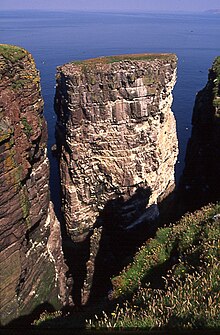
This is a list of stacks in Scotland that are surrounded by the sea at high tide.
The highest stacks in Scotland are Stac an Armin and Stac Lee in the St Kilda archipelago and the Old Man of Hoy, Orkney. Some provide well known and challenging rock climbing routes. There are 275 or more stacks in the country; their names are influenced by the Norse, Gaelic and English languages. In Shetland, where there are over 100 stacks, the names are often from Norn, a local variant of Norse.
The sport of stack climbing did not take off until the mid-1960s with the exploits of Tom Patey and in July 1967 15 million people watched the climbing of the Old Man of Hoy live on BBC television. The idea was originally suggested by Patey who helped put together a team of six climbers who were filmed undertaking the ascent. This was described as connecting "an armchair audience with the elite of a sport subculture intent on conquering one of Britain's most spectacular geological treasures”.[3] Following Patey's untimely death in 1970 development of the sport in Scotland largely ceased until the late 1980s and the arrival of Mick Fowler on the scene.[4]
Definitions and etymology[edit]

Cleare (1974) defined stacks from a rock-climbing perspective using three criteria:
- "A stack should be higher than it is wide in at least one of its planes.
- Within reason there is no minimum height, except that if it is high enough to be worth climbing, then it's a stack.
- A stack should have been formed by the action of the sea."[6]
Mellor (2020) offers similar conditions: "a stack is an isolated cone, pinnacle or tower of rock entirely surrounded by the sea at high tide."[7] He goes on to suggest that the difference between a stack and an island is that if the top is significantly wider in diameter than the height then it is an island, and that a stack should be at least 6 metres (20 ft) high.[7]
From a geological perspective a stack is a landform consisting of a steep and often vertical column or columns of rock in the sea near a coast, formed by wave erosion.[8] This definition excludes isolated steep-sided, rocky oceanic islets typically of volcanic origin, sometimes called "volcanic stacks". In the main listing below three different types of stack are identified:
- Sea stacks
- Outlying stacks, many of which are of volcanic origin
- Wide stacks that fail Mellor's definition of height to summit diameter above but which either have "stack" in their name or are clearly a "tower of rock entirely surrounded by the sea".
There are numerous small pinnacles around the Scottish coast, many of them in remote locations. Such features are often not well-documented and the main list is thus confined to the larger and better known examples.

The word 'stack' is derived from the Old Norse: stakk-r and is often rendered in the Norn of Shetland as stakk[10] and in modern Gaelic as stac or the plural stacan.[11]
Several descriptive names are used in more than one location. Examples include:
- Gaada Stack, meaning "hole stack" and used to describe stacks that incorporate natural arches;[12]
- Moo Stack, of which there are at least four in Shetland;[13]
- Brough, which is cognate with Old Norse: borg meaning "fortification" and broch;[14]
- Castle, Scottish Gaelic: caisteal, is typically used for an isolated stack;[15]
- Ern, Norn for "eagle".[16]
The name "stack" is however also sometimes appended to features other than sea stacks such as cliff-girt headlands and a number of such features are also listed below.
Distribution[edit]
Of the 275 stacks in Scotland identified by Mellor (2020) circa 110 are located around the coasts of Shetland of which 80 are around the coast of the Mainland. Most of the rest are found off the coasts elsewhere in the Highlands and Islands. He also lists 70 stacks in England, 10 in Wales and 55 off the island of Ireland.[17]
Climbing history[edit]

The first stack climbers in Scotland were the residents of the now uninhabited islands of Hirta and Mingulay who were dependent on the bounty provided by seabirds.[18][19] The first record of the recreational ascent of a sea stack in Scotland is likely that of Richard Manliffe Barrington, who climbed Stac Biorach in 1883.[Note 1] Sixteen years later Norman Heathcote and his sister Evelyn climbed Stac Lee.[26] He wrote that Stac Lee was "not a difficult climb" and that two other women had also reached the summit.[27]
Nonetheless, the main theme of the sport in the UK until the mid-1960s was "incidental stack climbing in pleasant and accessible locations".[20] Yorkshireman Ian Clough ascended one of Macleod's Maidens on Skye in 1959 but the picture changed completely with the exploits of Tom Patey, (aka "Doctor Stack") whose day job was as a GP in Ullapool. He began with the Old Man of Stoer in 1966 and followed this up with ascents of Am Buachaille, the Old Man of Hoy and the Great Stac of Handa.[20] After his death when descending The Maiden in 1970 "most Scottish stack explorations abruptly ceased".[28]
There was then a hiatus of a dozen years as climbers began "putting up harder and harder lines on comfortable stacks until they felt strong enough to venture north again".[28] In 1982 Arnis Strapcans put up a new route on the Old Man of Hoy. Two more routes were created on this stack in 1984 and with the arrival on the UK scene of Mick Fowler in 1985 events moved apace. He climbed the Old Man of Stoer in 1988 and numerous others over the next few years, "his most outrageous adventure" being on The Needle, another stack off the west coast of Hoy.[4] His regular partners on these exploits were Andy Nisbett, Craig Jones and Jon Lincoln who made up the "famous four" completing, for example, the first ascent of The Runk in Shetland in May 1992.[29]
Irishman Iain Miller made a solo second ascent of the Clett of Crura, South Ronaldsay in 1999 and since then has been involved in about 150 first ascents around Britain and Ireland. Nonetheless, in 2020 it was estimated that over 50 stacks around the British Isles have never been climbed.[30]
In 2019 Red Széll became the first blind climber to ascend the three “Tom Patey stacks” of Am Buachaille, the Old Man of Stoer and the Old Man of Hoy.[31] The 2020 film Climbing Blind documents the first blind lead of the Old Man of Hoy by Jesse Dufton.[32][33]
In 2023, by arrangement with the National Trust for Scotland, Stac Biorach was ascended again 130 years after Barrington became the first non-St Kildan to do so. Climber Robbie Phillips said it "was like walking in the footsteps, or climbing in the fingerprints, of the St Kildans. It’s a testament to their bravery and mental fortitude; to climb onto that sea stack 70m above the raging Atlantic without even shoes is wild to imagine".[22]
Main list[edit]
These are stacks which are well-known local landmarks greater than 15m in height, prominent rock climbing pinnacles, notable isolated stacks or are verified as being greater than 50 metres (160 ft) in height.
| Name | Type | Image | Coordinates | Location | Elevation[34] | Meaning of name | Notes |
|---|---|---|---|---|---|---|---|
| Am Buachaille | Sea stack | 
|
58°32′14.0″N 5°05′33.6″W / 58.537222°N 5.092667°W | Sandwood Bay, Sutherland | 65m[35] | The Herdsman[36] | First climbed in 1967 by Tom Patey, J Cleare and Ian Clough.[36][37][Note 2] |
| Am Plastair | Outlying stack | 
|
57°49′50.0″N 8°38′42″W / 57.830556°N 8.64500°W | St Kilda | 42m[38] | Possibly "the rascal" from Scottish Gaelic: peallastair[39][Note 3] | There is a fast tide race between this stack and Soay which "can make boating rather hazardous".[40] |
| Arnamul | Wide stack | 
|
56°48′N 7°40′W / 56.80°N 7.66°W | Mingulay, Outer Hebrides | 121m[41] | Of Norse origin, possibly "eagle holm"[42] or "eagle island"[43] | Although precipitous, sheep were grazed on its relatively flat summit during the human occupation of Mingulay.[44][Note 4] |
| Bow Fiddle Rock | Sea stack | 
|
57°42′23.8″N 2°51′00.9″W / 57.706611°N 2.850250°W | Moray | 15m[46] | The arch resembles the tip of a fiddle bow | |
| Bradastac | Sea stack | 
|
57°49′28.0″N 8°34′46.2″W / 57.824444°N 8.579500°W | St Kilda | 62m[47] | "Steep stack" from Old Norse: bratti-stakkr[48] | Located northwest of the summit of Conachair[41] where the sheer cliffs fall into the sea from a height of 427 metres (1,401 ft).[49] |
| Caisteal a' Mhorair | Sea stack |  [Note 5] [Note 5]
|
58°21′57.0″N 6°12′55″W / 58.365833°N 6.21528°W | North Tolsta, Lewis | 21m[Note 6] | Nobleman's castle[52] | The summit is encircled by the remains of a wall that surrounds a rectangular chamber that may have been a medieval stronghold.[50] |
| Cley Stacks | Sea stacks | 
|
60°15′46″N 1°41′58″W / 60.26278°N 1.69944°W | Walls and Sandness, Shetland | 60m[53] | May be related to Old Norse: kléi originally meaning steatite although there is no certain connection.[54] | There are two large stacks here. The eastern one reaches 55m but it is probably not completely seagirt.[55] Both have natural arches.[41] |
| Duncansby Stacks | Sea stacks | 
|
58°37′50.9″N 3°02′04.8″W / 58.630806°N 3.034667°W | Caithness | 85 m | Consists of 4 stacks; Great Stack, Witch’s Hat Stack, The Knee and The Little Knee.[56][Note 7] | The first ascent of the 85m Witch’s Hat was by Mick Fowler, Nikki Duggan, Paul Allison and Jon Lincoln in 1989.[57] |
| Dunnicaer | Sea stack | 
|
56°57′10.7″N 2°11′42.7″W / 56.952972°N 2.195194°W | Stonehaven | 21 m | A tautological placename meaning "fortress" | In 2015 excavations by an Aberdeen University team guided by climber Duncan Paterson revealed the presence of a Pictish hill fort.[58] |
| Erne's Stack (Bay of Deepdale) | Sea stack |  [Note 8] [Note 8]
|
60°16′19″N 1°41′28″W / 60.27194°N 1.69111°W | Bay of Deepdale, Shetland | 70m[59] | Eagle's stack | There are no records of any ascent of this stack which has a triangular cross-section.[60] |
| Erne's Stack (Wester Wick) | Sea stack | 
|
60°09′37″N 1°28′56″W / 60.16028°N 1.48222°W | Wester Wick, Shetland | 55m[61] | Eagle's stack | There are three large stacks here - Erne's Stack, a 55m stack southeast of Westerwick[41] Erne's Stack North, which reaches 51m[62] and Erne's Stack East, at 35m high.[63] |
| Gaada Stack | Sea stack | 
|
60°09′29.6″N 2°04′38.4″W / 60.158222°N 2.077333°W | Foula | 38m[64][Note 9] | Hole stack[12] | Comprising Devonian sandstone, there are two natural arches between three "legs".[64] |
| Gow’s Castle | Sea stack | 
|
57°43′10.4″N 3°22′34.4″W / 57.719556°N 3.376222°W | Moray | 10m | Gull's castle | The former Gow’s Castle Stack was destroyed in 1941 during bomb practice for WW2.[66][67] The existing stack was first climbed in 1986.[68] |
| Great Stac of Handa | Sea stack | 
|
58°23′15.5″N 5°11′50.1″W / 58.387639°N 5.197250°W | Sutherland | 72m[69][Note 10] | First climbed in 1876 by Donald McDonald[71] a native of St Kilda.[20] | |
| Hoo Stack | Outlying stack | 
|
60°14′57″N 1°05′22″W / 60.249180°N 1.089504°W | Nesting, Shetland | 34m[41] | It is 2.5km north-east of North Isle of Gletness | |
| Lianamul | Wide stack | 
|
56°48′58.9″N 7°39′28.2″W / 56.816361°N 7.657833°W | Mingulay, Outer Hebrides | 112m[72] | Flax mound[44] or island, although the reason is not clear.[43] | Martin Martin described the rock as "almost inaccesible, except in one Place... with the assistance of a Rope of Horse-hair."[73] |
| Maiden Stack | Sea stack |  [Note 11] [Note 11]
|
60°19′46″N 1°39′26″W / 60.32944°N 1.65722°W | Papa Stour, Shetland | 7.6m[74] | Also known as Frau Stack[75] and Muckle Fru[76] | In the 14th century a small house was built there by Þorvald Þoresson, in order to prevent his daughter from meeting men.[77] |
| Macleod’s Maidens | Sea stacks | 
|
57°19′57.3″N 6°34′56.9″W / 57.332583°N 6.582472°W | Skye | 65m | Three stacks supposedly named after the drowning of a MacLeod chieftain's wife and two daughters.[78] | Ian Clough climbed the first of the Maidens in 1959.[20] |
| Mina Stac | Sea stack | 
|
57°49′25″N 8°33′58″W / 57.82361°N 8.56611°W | St Kilda | 70m[79][Note 12] | "Lesser stack" from Old Norse: minni-stakkr[48] or possibly "smooth stack" from Scottish Gaelic: mìn[11] | |
| North Gaulton Castle | Sea stack | 
|
59°00′02.7″N 3°21′56.4″W / 59.000750°N 3.365667°W | South of Yesnaby, Orkney mainland | 50m | A Rover 214 car was helicoptered onto the summit for an advertisment in the Radio Times in 1994.[1][81] | |
| Old Man of Hoy | Sea stack | 
|
58°53′10.7″N 3°25′50.2″W / 58.886306°N 3.430611°W | Hoy, Orkney | 137m | Resembles a human figure. Originally the stack had an arch at the bottom giving the impression of two legs.[82][83] | The stack was first climbed in 1966.[84] In 1967 an ascent featured in a live BBC outside broadcast[3] featuring three pairs of climbers including Chris Bonington and Tom Patey.[85] |
| Old Man of Stoer | Sea stack | 
|
58°15′39.8″N 5°22′57.2″W / 58.261056°N 5.382556°W | Sutherland | 73m | First climbed in 1966 by Brian Henderson, Paul Nunn, Tom Patey, and Brian Robertson.[86] | |
| Out Stack | Outlying stack | 
|
60°51′37.1″N 0°52′25.1″W / 60.860306°N 0.873639°W | Shetland | 27m[41] | Known locally as "Ootsta"[87] | The northernmost point of Scotland. |
| Ramna Stacks | Outlying stacks | 
|
60°39′43″N 1°18′43″W / 60.66194°N 1.31194°W | Shetland | Ramma or Ramna is a disparaging term in Norn e.g. ramnatrack means ill-spun yarn.[88] | There are three stacks, with a fourth at Outer Stack just to the north.[89] | |
| Rockall | Outlying stack | 
|
57°35′46.7″N 13°41′14.3″W / 57.596306°N 13.687306°W | Oceanic | 17m | Uncertain | It is 301 kilometres (163 nautical miles) west of Soay, St Kilda. |
| Stac an Armin | Outlying stack | 
|
57°52′48.4″N 8°29′45.4″W / 57.880111°N 8.495944°W | St Kilda | 196m | Stack of the warrior[2] | The highest sea stack in Scotland. Three men and eight boys from Hirta were marooned here from about 15 August 1727 until 13 May 1728.[90] In July 1840, the last great auk seen in Britain was caught on the stack.[91] |
| Stacan Geodh Bhrisidh | Sea stack | 
|
58°23′13″N 5°11′55″W / 58.38694°N 5.19861°W | Handa | 40m[92] | Geodh a'Bhrisidh is the "narrow inlet of the break". | First ascent by Hamish Maclnnes, G.N. Hunter and D.F. Long in 1969.[70] |
| Stac an Dunain | Sea stack | 
|
58°37′37.2″N 5°00′16.2″W / 58.627000°N 5.004500°W | Sutherland | 50m | Possibly stack of the birds | |
| Stac an Tùill | Sea stack | 58°16′29″N 6°54′59″W / 58.27472°N 6.91639°W | Bearasay, Outer Hebrides | 43m[93] | Stack of the cave from Scottish Gaelic: tuill | There is a cave on Bearasay just to the north of the stack.[41] | |
| Stac Biorach | Outlying stack | 
|
57°49′41.4″N 8°37′20.1″W / 57.828167°N 8.622250°W | St Kilda | 73m | Sharply pointed stack[21] Also known as Thumb Stack because of the small size of the handholds.[21] | First described in 1698 its location "remained a mystery" until Barrington's ascent in the late 19th century.[22][Note 13] |
| Stac Clo Kearvaig | Sea stack | 
|
58°37′03.0″N 4°56′15.3″W / 58.617500°N 4.937583°W | Cape Wrath, Sutherland | 40m | Scottish Gaelic: clò has various meanings including "sea". Old Norse: ker means "sailing vessel".[95] This may then be "stack of the sea-galley bay".[96] | There are two summits, both first ascended in June 1989.[97] |
| Stac Dona | Outlying stack | 
|
57°49′32.3″N 8°37′29.6″W / 57.825639°N 8.624889°W | St Kilda | 27m | Scottish Gaelic: dona means "bad" | The St Kildans gave this name to the stack because it provided few nesting spaces for birds.[5] |
| Stac Lee | Outlying stack | 
|
57°51′58.4″N 8°30′35.5″W / 57.866222°N 8.509861°W | St Kilda | 172m | Possibly shelter stack[98] or the blue stack[99] | A small bothy on the summit was formerly used by St Kildan fowlers.[100] |
| Stac Levenish | Outlying stack | 
|
57°47′30.7″N 8°30′38.8″W / 57.791861°N 8.510778°W | St Kilda | 62m[41] | Scottish Gaelic: leibhinish means "stream" or "torrent"[101] | An underwater tunnel runs through the stack, creating a "cauldron of turbulent waters".[101] |
| Stac Shoaigh | Outlying stack |  [Note 14] [Note 14]
|
57°49′42.2″N 8°37′09.2″W / 57.828389°N 8.619222°W | St Kilda | 62m | Also known as Soay Stac | A tunnel runs through the stack.[102] |
| Stack of Old Wick | Sea stack | 
|
58°25′16″N 3°05′10″W / 58.42111°N 3.08611°W | Caithness | 40m | It is located just south of the Castle of Old Wick | The first ascent of the climb called "Lord Oliphant’s Bicycle" was by Mark Robson and Simon Richardson in 2004.[103] |
| Sule Stack | Outlying stack | 
|
59°01′25.7″N 4°30′24.7″W / 59.023806°N 4.506861°W | Orkney | 37m[104] | Gannet stack[105] | It is 49 kilometres (26 nautical miles) north of the Scottish mainland. |
| The Drongs | Outlying stack | 
|
60°27′45.1″N 1°31′45.5″W / 60.462528°N 1.529306°W | Shetland | 59m | The stacks, from Old Norse: drangr[10] | Consists of 4 stacks; Main Drong, Slender Drong, Slim Drong and Stumpy Drong.[106] They lie one kilometre off the coast of Hillswick Ness, Northmavine.[41] |
| The Fiddler | Sea stack | 
|
57°16′47″N 6°27′46″W / 57.27972°N 6.46278°W | Talisker Bay, Skye | 45m | There is a second 23m stack here, which may be called "The Bow".[107] | |
| The Maiden | Sea stack |  [Note 15] [Note 15]
|
58°34′46.1″N 4°35′08.4″W / 58.579472°N 4.585667°W | Sutherland | 56m | The Gaelic name Stacan Bana means "the female stacks" | On 25 May 1970, Tom Patey fell to his death attempting to abseil the Maiden.[109] The smaller "western stack" is 46m high.[97] |
| The Needle | Sea stack | [Note 16] | 58°47′29.76″N 3°18′47.52″W / 58.7916000°N 3.3132000°W | Hoy, Orkney | 61m | A grade XS 5c climb first ascended by Mick Fowler, Steve Sustad and Nikki Dugan in May 1990.[110] | |
| The Runk | Sea stack | 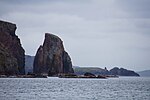
|
60°28′48″N 1°32′26″W / 60.48000°N 1.54056°W | St Magnus Bay, Shetland | 45m[111] | Norn: runk means "a big, stout person"[112] | First climbed in May 1992.[113] |
| Yesnaby Castle | Sea stack | 
|
59°01′02.8″N 3°21′38.2″W / 59.017444°N 3.360611°W | Yesnaby, Orkney mainland | 35m | First climbed in 1967 by a group including Joe Brown.[114] |
Other stacks[edit]

This is a selection of the many other stacks in Scotland. All the below are included in Mellor (2020) except those with the symbol № which have been identified from Ordnance Survey maps and/or other sources as cited. According to Mellor there is no record of some of them having been climbed.
Sutherland[edit]

- Stac na Faoileige, a 30m high stack off Handa[115]
- Am Bodach, 37m high by Cape Wrath[116]
- A’Chailleach, by Cape Wrath
- Stac Thormaid, A' Mhòine
- Geodha Brat East & West, A' Mhòine, 30 and 25m high respectively.[117]
- Puffin Stack, Melvich
- Lady Bighouse Rock, 25m high[118]
Caithness[edit]
- Fort Rock by Scrabster
- Clett Rock by Scrabster
- The Stacks by Dunnet Head
- Stack o' Brough, 35m high[119] south of Wick №
- South Stack, 44m high,[120] south of Stack o' Brough №
- Sinclair's Bay Stack
- Stack of Ulbster
- Roy Geo Stacks by Lybster
East coast[edit]
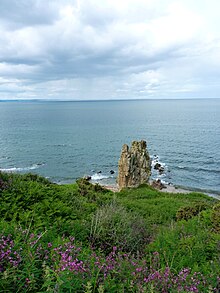
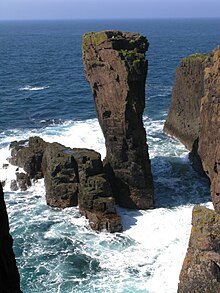
- Cummingston Main Stack near the village of Cummingston in Moray
- Logie Head Pinnacle near Cullen
- Head of Garness near Macduff
- The Tooth near MacDuff
- The Molar near MacDuff
- Dunbuy Rock, Cruden Bay
- The Sugar Loaf, Cruden Bay
- Berry’s Loup near Peterhead
- Oldcastle near Peterhead
- Long Slough Pinnacle south of Aberdeen
- The Humpback south of Aberdeen
- The Knapps Of Downies south of Portlethen
- Brown Jewel near the village of Muchalls in Aberdeenshire №
- May Craig, near Muchalls
- Doonie Point, near Muchalls
- Castle Rock Of Muchalls
- Elephant Rock south of Montrose
- Maiden Rock east of St Andrews
- Wheat Stack, near Coldingham
- The Souter, near Coldingham
Galloway[edit]

- Burrow Head, 30m high near Isle of Whithorn[122]
- Monreith Stack
- The Black Slab, Crammag Head, near Kirkmaiden
- Witch Rock, Portpatrick, first ascended in 1899[123]
- Juniper Rock, northwest of Stranraer
Islay and Jura[edit]
- American Monument Stacks, on the coast of The Oa, Islay
- Impact Stack, near Loch Tarbert, Jura[Note 17]
Mull and environs[edit]

- Castle Coefin, Lismore
- Carsaig Stack, Mull
- Stac Glas Bun Un Uisge, Mull
- Croig, Mull
- Quinish Poiunt, Mull
- Stac an Aoineidh, Iona
- Stac Leath, Iona
- Stac Mhic Mhurchaid, Iona
- Am Buchaille, Staffa
- Dun Cruit, Lunga
Small Isles[edit]

- The Spichean, Muck
- Stac nam Faoileann, Rùm
- Covenanter's Point Stack
- Papadil Pinnacle, Rùm
- Fist and Finger, Rùm
- Harris Bay Stack, Rùm
- An Coroghon, Canna
- An t-Each, Canna
- An Caraghon, Canna
- Lorcail
Skye[edit]

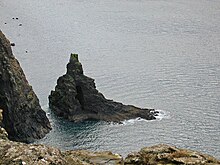
- Bob Bob Stack, Trotternish
- Broken Needles, Trotternish
- Stac Buidhe, Trotternish
- Stac Laclainn, Trotternish
- Stacan Gobblach, Trotternish
- Rubha Hunish Stacks, Trotternish
- Stack of Skudiburgh, Trotternish
- Ru Idrigill Stack, Trotternish
- Glen Lorgasdal Stacks, Duirinish
- Stack a'Mheadhais, Minginish
- Stac an Tuill, Minginish
- Stac Suisnish, near Torrin
- Fladda-chùain stacks
Outer Hebrides[edit]

- Stac Shuardail, south of Knock, Lewis
- Stac na Caoraich Lachduinne, Carloway
- Stac a’Bhanain, Loch Roag
- Stacan Neadacliv, near Uig
- Stac na Berie, Uig
- Stac Leathann, Uig
- Stacageo, near Mealista
- Haskeir Eagach
- An Stac, off Eilean Leathan, Eriskay, although it is not clear there is a genuine sea stack here
- Gèarum Beg, Mingulay
- Gèarum Mòr, 51m high but arguably a precipitous islet rather than a true stack. In 1868 a wave washed over the top of it.[124]
- Na Gilleachan Ruadh at the northern tip of Mingulay, aka The Red Boy[44] №
St Kilda[edit]

- Sgarbhstac, Boreray from Old Norse: skarfa-stakkr meaning "cormorant stack"[48] №
- Sgeir Mhòr, at the foot of the cliffs of Mullach Bi №
- Sgeir Cùl an Rubha, on the western side of Dùn[41] №
- There is a small, unnamed stack east of Sgeir Cùl an Rubha and the headland of Giumachsgor[125] №
Orkney[edit]
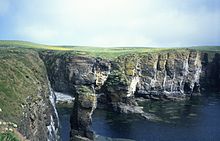
- Stack of Kame, South Ronaldsay
- Clett of Crura, South Ronaldsay
- Stackabank, South Ronaldsay
- Stack o'Roo, Birsay
- Standard Rock, Birsay
- Hemp Stack, south of Kirkwall
- The Brough, Stronsay
- Castle o' Burrian, Westray
Shetland islands[edit]
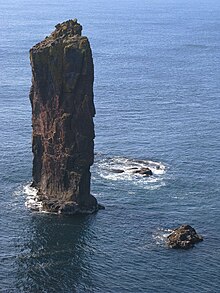
Fair Isle[edit]
- Stacks of Wirrvie
- Stacks of Skroo
- Breiti Stack
- Fogli Stack
- Hundi Stack
West and East Burra[edit]

- Stacks of Houssness at the south end of East Burra
- Fugla Stack, a 33m high stack[41] west of The Ward, West Burra
- Clettnadel, a small stack just north of Fugla Stack
- Kame of Riven Noup, a "wafer-like entity" north of Clettnadel.[127] The name may mean "comb of the torn headland" and is the subject of a poem by Martha Morton from Brae.[128]
- Stack of Sandwick has an arch is and is located west of Bridge End, West Burra
Vaila[edit]
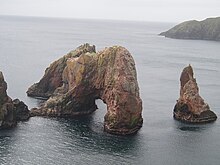
- Gaada Stacks
- Humla Stack
Papa Stour[edit]

- Lyra Skerry Stack
- Galti Stacks
- The Foot
- Snolda Stack №
Vementry and Muckle Roe[edit]

- Swaba Stack, Vementry
- Murbie Stacks, in the southwest of Muckle Roe
- Riding Stack, north of Murbie Stacks
- The Spindle, north of Riding Stack, off West Hill of Ham №
- Da Kist, off Moo Ness[Note 19] №
- Muckle Roe Stack, off Tame Holm[129][Note 20]
- Swabi Stack 46m high in the northwest of Muckle Roe[129][130]
Fetlar[edit]

- Stack of Birrier
- Stacks of Scambro
- Furra Stacks
- Stackan Longa
- Bratta Stack
- Stack of Grunnigeo
- The Clett №
Yell[edit]

Ern Stack on the west coast is not a sea stack - see below.
- Sweinna Stack, north of Scattalands on the west coast
- Horns of the Roe, north of Sweinna Stack
- Whale Geo Stacks, north of Horns of the Roe
- Aastack, north of Whale Geo Stacks
- Stacks of Stuis, at the entrance of Whale Firth
- Aastack, south of Baagi Stack
- Baagi Stack, south of Whilkie Stack
- Whilkie Stack, by Gloup Holm
- Eagle Stack, by Gloup Holm
- Stack of the Horse, Burravoe
Unst[edit]

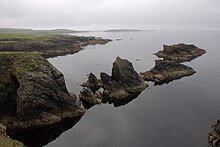
As with elsehere on Shetland the profusion of offshore islets and stacks create definitional problems. For example, The Greing north of Urda Stack is 53m high and is steeply sloping on one side and perpendicular cliffs on the other so not included.[131] The name "stack" is also sometimes used for a headland, e.g. Sothers Stack, Hermaness or the nearby 55m high Humla Stack,[132] which are included in Mellor's list of possible candidates[133] or for rocky islets that come nowhere near meeting the definitions above e.g. Breiwick Stack, which is more of a skerry.[134]
- Lamba Stack, a small stack north of Belmont
- Sinna Stack, west of Baltasound
- Gamli Stack, north of Sinna Stack
- Skate Stack, northwest of Gamli Stack
- Stacks of Poindie, north of Skate Stack
- Tonga Stack, off the Tonga headland west of Burrafirth
- Longa Stacks, close to Tonga Stack
- Neapna Stack, north of Longa Stacks, possibly exceeding 50m[41] №
- Tooa Stack, north of Neapna Stack №
- Stackins-hocka, offshore from Tooa Stack.[Note 21]
- Stackingro, off the west coast of Hermaness
- Flodda Stack, north of Stackingro
- Urda Stack, 35m high near the northern tip of Hermaness[135] №
- Burra Stack, with a natural arch and 44m high, north of Urda Stack[136]
- Wilna Stack, at the northern tip of Hermaness №
- Wurs Stack, Hermaness, a small stack next to an unnamed skerry[41]
- Root Stacks, small stacks at the head of Burra Firth
- Holey Kame, a 29m stack northeast of Burrafirth[41] №
- Tooral Stack, a 27m stack north of Holey Kame[41] №
- Hinda Stack, a 21m stack north of Tooral Stack[41] №
- Whida Stack, Brei Wick, northeast of RAF Saxa Vord - two stacks one of which reaches 34m[41] №
- Gerva Stacks, east of Brei Wick - two stacks one of which reaches 31m[41] №
- Cudda Stack, a small stack near the headland of North Coos, north of Nor Wick
- Stack of Louin, east of Norwick
- Stack of Russalore, west of Stack of Louin
- North Stane, 28m high and east of the village of Saxa Vord[41] №
- Ship Stack, south of North Stane
- Hagmark Stack, 21m high and south of Ship Stack
Muckle Flugga[edit]

- Muckle Flugga comes equipped with a lighthouse but has had "many ascents"[137]
- Little Flugga reaches 31m[41] №
- Vesta Skerry reaches 48m[41] №
Foula[edit]
- Gaada Stack
- Da Stacs o' Logat
- Rippack Stack
Shetland mainland[edit]

Northmavine[edit]

- Moo Stack, off Esha Ness
- Stack of Sumra, Ronas Voe
- Galti Stack, just off The Faither, Ronas Voe
- Point of Quida-stack, Ronas Voe
- Gruna Stack and Little Gruna Stacks, north of Ronas Voe
- Galti Stack, east of Uyea
- Out Shuna Stack, west of Uyea
- Yellow Stack, 45m high at Point of Fethaland[138]
- Stuack, Point of Fethaland
- Bark Stack, Point of Fethaland
- Ramna Stacks, north of Point of Fethaland
- Outer Stack, north of Ramna Stacks
- Stack of Stavgeo, Yell Sound
- Stack of the Rettuvie, Yell Sound
- Stack of the Crubb, Yell Sound
- The Castle, Yell Sound
- Trolla Stack, Yell Sound
Nesting and South Mainland[edit]

- Ura Stack, near the farm of Neap
- Fru Stack, off Moul of Eswick
- Hoo Stack, about a mile offshore from Moul of Eswick
- Stacks of Vatsland, north of Gremista, Lerwick
- Holm of Noss - unnamed stack c. 50m high.[139]
- Punds Stack off Ness of Trebister, south of Lerwick
- Quarff Stack, by Quarff
- Coall Head Stacks, south of Quarff
- Stack of Okraquoy, near Falddabister
- Stack of Billyageo, off No Ness, south of Mousa
- Stack of the Brough, Boddam
- Stack of Otter Geo, east of Sumburgh Airport
- Broad Stack, west of Sumburgh Airport
- Ripack Stack, close to Broad Stack
- Landvillas, Wick of Shunni
- Clocki Stack, northwest of Loch of Spiggie
Wester Wick[edit]

- Moo Stack, south of Skeld
- Berga Stack, Sil Wick №
- Skerry of the Wick, 35m high[41] №
- Westwick Stacks, including Gro Stack in the bay of Wester Wick
- Grossa Stack, Wester Wick №
- The Cutter, a 31m ascent[127]
- Groni Stack, a 46m stack just north of The Cutter[41] №
- Burga Stacks, southwest of Culswick
- Seli Stack, northwest of Culswick in Gruting Voe
Walls and Sandness[edit]

- Lang Stack, a 50m stack northwest of Dales[141]
- West Stack, west of Mid Walls
- Rusna Stacks, at the entrance to Vaila Sound
- Litla Stack, in the Bay of Deepdale
West Burra Firth[edit]
- Lang Stack, off Snarra Ness
- Galta Stack
- Swaaba Stack №
- Turl Stack, east of Isle of West Burrafirth
St Magnus Bay (north)[edit]
- Gordi Stack, south of Hillswick, which is 50m high[140]
- Oe Stack, south of the Isle of Nibon
- Moo Stack, north of Eina Stack
- Eina Stack, 30m high, northwest of Mavis Grind[142]
Places called "stack" etc. that are not sea stacks[edit]

- Stac Pollaidh is a hill in Sutherland
- Erne Stack on Muckle Roe is "connected to the shore by a thin neck".[143]
- Ern Stack, Yell is a prominent feature with twin towers of white rock first climbed in 1980. It is also the last recorded nesting site of the Eurasian sea eagle in Shetland. However it is not sea-encircled.[9][144]
- The Old Man of Storr is an inland pinnacle on Skye.
- Leac Mhina Stack (Ledge of Mina Stack) is a headland on the east coast of Hirta facing Mina Stack.
- Stac a’ Langa is a narrow promontory at the foot of the cliffs of eastern Hirta.
- Stac Dhomhnuill Chaim, Mangersta, is circa 50m high but joined to Lewis by a narrow spine of rock.[145]
- Stack of the Ship, which is attached to St Ninian's Isle by a "a knife-edged arête".[41][146]
See also[edit]
Notes[edit]
- ^ This ascent of Stac Biorach is the subject of a number of conflicting assertions. Mellor has this FA taking place in 1883 by "a C. Barrington".[20] Similarly, Haswell-Smith describes the training of young St Kildan's on the stack recorded in 1698 and then states that "The first recorded outsider to climb both this stack and Stac Lee was Charles Barrington in 1883".[21] This refers to Richard's brother Charles who would have been 49 years old in 1883. Quine also states that the FA was in that year but by Richard Barrington.[5] The National Trust for Scotland have R. Barrington as the climber but the date as 1890.[22] There is thus confusion about both the date of the ascent and which brother was the ascender. However, R. Barrington was 16 years younger than Charles and the Dictionary of Irish Biography makes it clear that it was the former who travelled to "remote islands off Scotland (1883, 1886, 1890)".[23] The original paper by R. Barrington in the Alpine Journal in 1913 also states that the year of the ascent was 1883 and that he ascended the stack with the help of two St Kildans, Donald McDonald and Donald McQueen.[24] Barrington wrote “the fact that a certain rivalry existed between myself and an elder brother who first ascended the Eiger induced me to visit St. Kilda in 1883, as I wished to test the ability of the natives as cragsmen, to compare them with Swiss guides, and to study the fauna and flora of this remote island, of which little was then known. It is thirty years ago next June since I ascended Stack-na-Biorrach, and therefore I trust I shall not be accused of hasty self-advertisement”.[25]
- ^ Gazetteer for Scotland states the FA was in 1968.
- ^ Quine (2000) suggests the name may mean Blue Stack "if Scandinavian... otherwise, Place of Splashing".[40]
- ^ Although the Mingulay outliers of Aranamul and Lianamul do not necessarily meet rock climbing definitions of a stack, they are often referred to as such by writers with other interests e.g. Haswell-Smith,[44] Buxton and Harvie-Brown.[45]
- ^ There are several stacks on Tràigh Ghearadha that increase in size from north to south. Caisteal a' Mhorair is the tallest of these at right on this image. See Canmore for an aerial photo.[50]
- ^ Probably referred to as "Grey Castle" by Mellor (2020), which he lists as 70m in height.[51] Canmore has a more realistic figure of 70 feet (21 m).[50]
- ^ Witch’s Hat Stack would seem to be, on the evidence of Mellor (2020) and elsewhere, the highest stack off the coast of the island of Great Britain but no source specifically confirming this has yet been found.
- ^ The stack is in the middle distance, at the southern extremity of Bay of Deepdale in this image. The much smaller Litla Stack is also shown in front of Erne's Stack.
- ^ Another source has 32m.[65]
- ^ Mellor (2020) has "about 107m high".[70]
- ^ Brei Holm is at right with Maiden Stack immediately to its left. An unanmed stack in front of Maiden Stack appears as if joined to it to the left of the highest point.
- ^ Gazetteer for Scotland has "approximately 70m". A second source states 61m.[80]
- ^ Quine (2000) describes Stac Biorach as "almost inaccessible" and adds that "even the St Kildans stopped climbing it around 1840".[94] However, this cannot be entirely true given their assistance to Barrington in 1883.[24]
- ^ Stac Shoaigh at right with Stac Biorach at left.
- ^ The Maiden at right with the "western stack" at left.[108]
- ^ There is an image of the area at Geograph here. The Needle is at right just to the left of the entrance to the narrow geo at far right.[41]
- ^ The location is not clear and it may be a stack on the many cliffs in that area rather than a sea stack.
- ^ Mellor (2020) lists Am Bhiran at the same location, which may be the smaller of the two stacks in the image.
- ^ Not named on Ordnance Survey maps.
- ^ Not named on Ordnance Survey maps.
- ^ Mellor records this small stack as "Kame of Flouravoug" but as the name implies this is a headland.[133][41]
Footnotes[edit]
- ^ a b Mellor 2020, p. 160.
- ^ a b Haswell-Smith 2004, p. 325.
- ^ a b "The Great Climb". BBC Scotland. Retrieved 10 December 2011.
- ^ a b Mellor 2020, pp. 11–12.
- ^ a b c Quine 2000, p. 121.
- ^ Cleare 1974, pp. 47–48.
- ^ a b Mellor 2020, p. 5.
- ^ "Sea stacks" britannica.com Archived 14 April 2009 at the Wayback Machine
- ^ a b Mellor 2020, pp. 210–11.
- ^ a b Jakobsen 1897, p. 103.
- ^ a b "The Gaelic origins of place names in Britain". Ordnance Survey. Retrieved 12 March 2024.
- ^ a b "The North End". (2012) Foula Heritage Ranger Service. p. 1
- ^ Mellor 2020, p. 206.
- ^ "The Castle of Brough". Caithness Broch Project. Retrieved 28 March 2024.
- ^ Mellor 2020, p. 328.
- ^ Jakobsen 1928, p. 148.
- ^ Mellor 2020, pp. 5–6.
- ^ Mellor 2020, p. 8.
- ^ Haswell-Smith 2004, p. 209.
- ^ a b c d e Mellor 2020, p. 9.
- ^ a b c Haswell-Smith 2004, p. 323.
- ^ a b c "Robbie scales ‘The Thumb’ in St Kilda". National Trust for Scotland. Retrieved 31 March 2024.
- ^ "Barrington, Richard". Dictionary of Irish Biography. Retrieved 31 March 2024.
- ^ a b Barrington 1913, pp. 199–201.
- ^ Barrington 1913, p. 197.
- ^ Heathcote (1900), p. 106.
- ^ Heathcote (1900), pp. 139–140.
- ^ a b Mellor 2020, p. 11.
- ^ Mellor 2020, p. 335.
- ^ Mellor 2020, p. 12.
- ^ “Triple Sea Stack Success for Blind Climber Red Széll”. UK Climbing. Retrieved 9 April 2024.
- ^ “Climbing Blind” Brit Rock Films. Retrieved 9 April 2024.
- ^ "Blind climber leads an ascent of the Old Man of Hoy". BBC News. 6 June 2019. Retrieved 9 April 2024.
- ^ Mellor (2020) unless otherwise stated.
- ^ "Am Buachaille". Gazetteer for Scotland. Retrieved 10 March 2024.
- ^ a b Mellor 2020, p. 151.
- ^ "Sandwood Bay". walkhighlands. Retrieved 22 Jan 2021.
- ^ "Am Plastair". Hill-bagging.co.uk. Retrieved 23 March 2024.
- ^ Hutchinson 2014, p. 34.
- ^ a b Quine 2000, p. 114.
- ^ a b c d e f g h i j k l m n o p q r s t u v w x y z Ordnance Survey. OS Maps Online (Map). 1:25,000. Leisure.
- ^ Gammeltoft 2006, p. 81.
- ^ a b Buxton 1995, p. 33.
- ^ a b c d Haswell-Smith 2004, p. 211.
- ^ Buxton 1995, pp. 13–15.
- ^ "Bow Fiddle Rock, Portknockie, Moray". livebreathescotland.com. Retrieved 20 March 2024.
- ^ "Bradastac". Gazetteer for Scotland. Retrieved 10 March 2024.
- ^ a b c Taylor 1968, p. 126.
- ^ Keay 1994, pp. 840–2.
- ^ a b c "Lewis, North Tolsta, Traigh Geiraha, Caisteal a' Mhorair". Canmore. Retrieved 25 March 2024.
- ^ Mellor 2020, p. 132.
- ^ "Caisteal a' Mhorair". Outer Hebrides Tourism. Retrieved 25 March 2024.
- ^ "Cley Stack West". Hill-bagging.co.uk. Retrieved 28 March 2024.
- ^ Jakobsen 1928, p. 427.
- ^ "Cley Stack East". Hill-bagging.co.uk. Retrieved 28 March 2024.
- ^ Mellor 2020, p. 222.
- ^ Mellor 2020, p. 224.
- ^ Stalker, Fiona (16 April 2015). "'Significant' Pictish fort discovery". BBC News. Retrieved 9 March 2024.
- ^ "Erne's Stack". Hill-bagging.co.uk. Retrieved 23 March 2024.
- ^ Mellor 2020, p. 199.
- ^ "Erne's Stack". Hill-bagging.co.uk. Retrieved 28 March 2024.
- ^ "Erne's Stack North". Hill-bagging.co.uk. Retrieved 28 March 2024.
- ^ "Erne's Stack East". Hill-bagging.co.uk. Retrieved 28 March 2024.
- ^ a b "Gaada Stack". Gazetteer for Scotland. Retrieved 04 April 2024.
- ^ "Gaada Stack". Hill-bagging.co.uk. Retrieved 23 March 2024.
- ^ "Gow's castle Rock". hopemanhistory. Retrieved 23 Jan 2021.
- ^ Megarry, Jacquetta (18 Sep 2010). "Sea stack mystery". jacquetta. Retrieved 23 Jan 2021.
- ^ Mellor 2020, p. 236.
- ^ "Great Stac of Handa". Themountainguide.co.uk. Retrieved 30 March 2024.
- ^ a b Mellor 2020, p. 149.
- ^ "Handa Island, In more detail". northcoastseatours. Retrieved 23 Jan 2021.
- ^ Buxton 1995, p. 12.
- ^ Buxton 1995, p. 79.
- ^ "Papa Stour, Maiden Stack". Canmore. Retrieved 04 April 2024.
- ^ Haswell-Smith 2004, pp. 451–52.
- ^ "Papa Stour". Shetland Amenity Trust. Retrieved 04 April 2024.
- ^ Haswell-Smith 2004, pp. 431–32.
- ^ Haswell-Smith 2004, p. 177.
- ^ "Mina Stac" Gazetteer for Scotland. Retrieved 23 March 2024.
- ^ "Mina Stac" Hill-bagging.co.uk. Retrieved 23 March 2024.
- ^ "Down Rover". orkneycommunities.co.uk. Retrieved 14 March 2024.
- ^ Jim Hansom. "Old Man of Hoy". Archived from the original on 1 February 2014. Retrieved 25 January 2014.
- ^ "William Daniell: The Old Man of Hoy". Tate. Retrieved 14 January 2013.
- ^ "1966 climb: The Old Man of Hoy". Mountaineering Council of Scotland. Archived from the original on 10 August 2009. Retrieved 25 January 2014.
- ^ Latter 2009, p. 452
- ^ Mellor 2020, p. 144.
- ^ Haswell-Smith 2004, p. 484.
- ^ Jakobsen 1932, p. 682.
- ^ Mellor 2020, p. 186.
- ^ Rackwitz 2007, p. 352.
- ^ Rackwitz 2007, p. 347.
- ^ "Stac a'Bhrisidh". Themountainguide.co.uk. Retrieved 30 March 2024.
- ^ "Stac an Tuill" Hill-bagging.co.uk. Retrieved 24 March 2024.
- ^ Quine 2000, p. 111.
- ^ Jakobsen 1897, p. 135.
- ^ "Etymology of Kearvaig". walkhighlands.co.uk. Retrieved 13 March 2024.
- ^ a b Mellor 2020, p. 154.
- ^ Haswell-Smith 2004, pp. 325–26.
- ^ Quine 2000, p. 137.
- ^ Haswell-Smith 2004, p. 326.
- ^ a b Quine 2000, p. 109.
- ^ Mellor 2020, p. 139.
- ^ Mellor 2020, p. 226.
- ^ "Sule Stack SSSI". (August 2011). Scottish Natural Heritage/Nature Scot.
- ^ Haswell-Smith 2004, p. 329.
- ^ Mellor 2020, pp. 204–05.
- ^ Mellor 2020, pp. 128–29.
- ^ Mellor 2020, p. 155.
- ^ Mellor 2020, p. 331.
- ^ Mellor 2020, p. 180.
- ^ "The Runk". Hill-bagging.co.uk. Retrieved 21 March 2024.
- ^ Jakobsen 1932, p. 726.
- ^ Mellor 2020, pp. 205–06.
- ^ "Yesnaby Castle". orkney-seastacks. Retrieved 22 Jan 2021.
- ^ " Stac na Faoileige". Themountainguide.co.uk. Retrieved 30 March 2024.
- ^ "Am Bocach". Hill-bagging.co.uk. Retrieved 29 March 2024.
- ^ Mellor 2020, pp. 157–58.
- ^ Mellor 2020, pp. 159.
- ^ "Stack o' Brough". Hill-bagging.co.uk. Retrieved 29 March 2024.
- ^ "South Stack". Hill-bagging.co.uk. Retrieved 29 March 2024.
- ^ Mellor 2020, p. 117.
- ^ Mellor 2020, p. 111.
- ^ Mellor 2020, p. 330.
- ^ Buxton 1995, p. 16.
- ^ "General oblique aerial view of St Kilda, centred on Village Bay and the island of Dun". Canmore. Retrieved 11 April 2024.
- ^ Mellor 2020, pp. 166–67.
- ^ a b Mellor 2020, p. 196.
- ^ "S6 - Bree - Martha Morton - The Kame of Riven Noup". (pdf) University of Glasgow. Retrieved 30 March 2024.
- ^ a b c Mellor 2020, p. 202.
- ^ "Swabi Stack". Hill-bagging.co.uk. Retrieved 28 March 2024.
- ^ "The Greing". Hill-bagging.co.uk. Retrieved 07 April 2024.
- ^ "Humla Stack". Hill-bagging.co.uk. Retrieved 07 April 2024.
- ^ a b Mellor 2020, p. 215.
- ^ "Breiwick Stack, Ham Ness". Wikimedia Commons. Retrieved 07 April 2024.
- ^ "Urda Stack". Hill-bagging.co.uk. Retrieved 07 April 2024.
- ^ "Burra Stack". Hill-bagging.co.uk. Retrieved 08 April 2024.
- ^ Mellor 2020, p. 216.
- ^ "Yellow Stack". Hill-bagging.co.uk. Retrieved 30 March 2024.
- ^ Mellor 2020, p. 189.
- ^ a b "Gordi Stack". Hill-bagging.co.uk. Retrieved 28 March 2024.
- ^ "Lang Stack". Hill-bagging.co.uk. Retrieved 28 March 2024.
- ^ "Eina Stack". Hill-bagging.co.uk. Retrieved 28 March 2024.
- ^ Mellor 2020, pp. 202–03.
- ^ Haswell-Smith 2004, p. 470.
- ^ "Stac Dhomhnuill Chaim". Outer Hebrides Tourism. Retrieved 24 March 20204.
- ^ Mellor 2020, p. 193.
References[edit]
- Cleare, John (1974). "Sea Stacks". Alpine Journal. 79. London: The Alpine Club: 47-54.
- Barrington, Richard M. (1913). "The Ascent of Stack-Na-Biorrach (The Pointed Stack), St Kilda". Alpine Journal. 27. London: Longmans, Green: 195-202.
- Buxton, Ben (1995). Mingulay: An Island and Its People. Edinburgh: Birlinn. ISBN 1-874744-24-6.
- Gammeltoft, Peder (2006). "Scandinavian influence on Hebridean island names". In Gammeltoft, Peder; Jorgenson, Bent (eds.). Names through the Looking-Glass. Copenhagen: C.A. Reitzels Forlag. ISBN 8778764726.
- Haswell-Smith, Hamish (2004). The Scottish Islands. Edinburgh: Canongate. ISBN 978-1-84195-454-7.
- Heathcote, Norman (1900). St Kilda. London: Longmans, Green & Co.
- Hutchinson, Roger (2014). St Kilda: A People’s History. Edinburgh: Birlinn. ISBN 0857908316.
- Jakobsen, Jakob (1897). "The old Shetland place-names". The dialect and place names of Shetland; two popular lectures (Lecture). Cornell University Library. Lerwick: Lerwick, T. & J. Manson. LCCN 03002186. Retrieved 2019-10-07 – via archive.org.
- Keay, J. and J. (1994). Collins Encyclopaedia of Scotland. London: HarperCollins. ISBN 0-00-255082-2.
- Latter, Gary (2009). Scottish Rock: North. Pesda Press. ISBN 9781906095079.
- Mellor, Chris (Jan 2020). "An illustrated guide to sea stack climbing in the UK & Ireland" (PDF). needlesports. Retrieved 23 Jan 2021.
- Quine, David (2000). St Kilda. Grantown-on-Spey: Colin Baxter Island Guides. ISBN 1-84107-008-4.
- Rackwitz, Martin (2007). Travels to Terra Incognita: The Scottish Highlands and Hebrides in Early Modern Travellers' Accounts C. 1600 to 1800. Waxmann Verlag. ISBN 978-3-8309-1699-4.
- Taylor, A. B. (1968). "The Norsemen in St Kilda". Viking Society for Northern Research. 17. JSTOR: 116–144. Retrieved 24 March 2024.
Dictionaries
- Am Faclair Beag: An English – Scottish Gaelic dictionary incorporating Dwelly Faclair.com. Retrieved 27 March 2024.
- John J. Graham's Shetland Dictionary. Shetlanddialect.org. Retrieved 25 March 2024.
- Jakobsen, Jakob (1928). An Etymological Dictionary of the Norn Language in Shetland. Vol. 1. London: David Nutt. Retrieved 2024-04-03.
- Jakobsen, Jakob (1932). An Etymological Dictionary of the Norn Language in Shetland. Vol. 2. London: David Nutt. Retrieved 2024-04-02.

